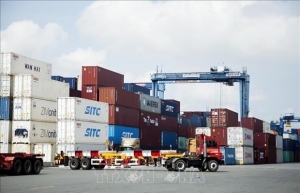Vigilance a must in order to prepare for fiscal stress
Vietnam grew 5.05 per cent in 2023. How does the International Monetary Fund view this growth rate, as compared to other ASEAN countries?
 |
| Paulo Medas, mission chief for Vietnam of the International Monetary Fund |
After recording a very strong year in 2022, growth came down significantly in 2023. In the first half of 2023, economic growth slowed to 3.7 per cent on-year, with investment recording one of the worst performances in more than a decade.
This was driven by both domestic and external factors, including the turmoil in the real estate sector and corporate bond market, and the sharp contraction in exports due to weak economic growth in many of Vietnam’s main markets. The economy started to rebound in the second half of 2023, and we believed that annual growth for 2023 was going to be slightly below 5, at around 4.7 per cent.
Vietnam’s performance compares relatively well when global growth is expected to remain modest. Even in Asia, which accounts for most of the world’s growth, Vietnam’s performance compares well within the region. The country’s growth in 2023 was a bit higher than the average growth estimated for Indonesia, Malaysia, the Philippines, Singapore, and Thailand.
We expect that Vietnam’s growth performance will be stronger than the average for the ASEAN region in 2024, but important risks remain given a still challenging global environment. If global growth disappoints, it could significantly affect the nascent recovery in Vietnamese exports. It will also be critical to address domestic risks, for example in the real estate market, and reduce costs to doing business and invest.
Vietnam implemented an economic recovery programme that was ran until the end of 2023. However, there is now a proposal to utilise it in 2024. In your view, is this necessary?
We have been arguing that fiscal policy can take a leading role in supporting economic growth, including through accelerating critical public investment and extending social safety nets. As monetary policy has little space left to manoeuvre (interest rate differentials relative to other countries can generate exchange rate pressures), it’s time for fiscal policy to pick up, making use of the prudent policies of past years.
The Programme on Socioeconomic Recovery and Development in question was a step forward in this regard, and we welcome the recent acceleration in public investment deployment.
It is important to emphasise that these are longstanding issues, requiring deeper reforms over time. It is key to strengthen social safety nets that can be swiftly, automatically activated and that allow the government to provide targeted support to the most vulnerable in bad times.
For example, when economic growth slows significantly or the cost-of-living increases sharply, the government should be able to quickly deploy targeted support, including cash transfers to the poorest households or those that lose their jobs. In addition, public investment is and will be needed to ensure Vietnam can achieve its development goals over the medium term.
While the country’s performance has been strong, moving to the next stage will require large, and high quality, investments into expanding and modernising infrastructure as well as adapting to climate change.
 |
The government has been encouraging the banking sector to increase loans as a means of stimulating economic growth. But many enterprises are facing challenges and are not seeking additional loans. How do you interpret this paradox?
Financial conditions tightened earlier in the year, but credit growth seems to have picked up in recent months. That said, it’s not really a paradox, but one needs to distinguish the different forces at play. While falling interest rates can lead to higher credit growth, there are other factors that can tamper that effect.
The demand for credit by firms depends on their needs for working capital or investments. In 2023, businesses faced weaker external demand, and softer consumption growth, which can explain why firms may be reluctant to take more debt even if interest rates fall. In such conditions, pushing too hard to increase credit may result in some loans being issued for too risky projects, which may generate problems down the road.
It is also important to note that Vietnam already has a fairly large amount of credit as a share of GDP (over 120 per cent) following years of very strong credit growth. In addition, non-performing loans are increasing. To manage risks to asset quality, it is essential to have proper bank regulation and supervision, and that’s why we advise having in place strong and modern macro and micro prudential policies.
What is your assessment of the effectiveness of Vietnam’s monetary policy in 2023, and what recommendations would you make for 2024?
The monetary policy is tasked with multiple responsibilities that are not always easy to reconcile with one another. It is worth mentioning that the State Bank of Vietnam (SBV) has managed to keep inflation under control, while containing disruptions on the exchange rate, without losing foreign exchange reserves.
Further, the SBV also had to ensure financial stability, in a weak growth environment, under tightened financial conditions following events at home (intervene in Saigon Commercial Joint Stock Bank) and abroad (for example, financial stress in some US banks), and without much room to lower policy rates. Going forward, it is likely that the SBV will continue with little room for easing monetary policy, and our advice is to remain vigilant on financial stability and inflation dynamics. The fiscal policy should take a leading role in supporting growth.
It should also be noted that the monetary policy framework needs prompt modernisation to improve its effectiveness. The SBV’s toolkit should move away from tools such as credit growth ceilings and deposit interest rate caps and adopt market-based mechanisms along with appropriate macro-prudential measures, as well as allowing for greater exchange rate flexibility.
What are your expectations for the economic outlook of Vietnam in 2024?
Global growth is likely to remain modest by historical standards, but overall conditions for Vietnam will be more benign, allowing for a stronger recovery. We project that growth in 2024 will rise to 5.8 per cent.
This reflects several factors. For instance, a pickup in exports will help manufacturing (and other exporting sectors) to gain some steam after the downturn in 2023. This should also contribute to a stronger investment and consumption performance.
However, it will be important to address swiftly the weaknesses that could hamper growth. This includes addressing the problems in the real estate sector and the excessive leverage among some firms that could hurt the corporate bond market and undermine the ability to lend by the more exposed banks.
However, downside risks remain, including because of the uncertain global environment. Nevertheless, if Vietnam continues to make the necessary economic and climate-related reforms and investments, it can sustain high medium-term economic growth and become a greener economy.
 | Vietnamese economy likely to expand by 6.5 per cent in 2024: Economist The Vietnamese economy is likely to expand by 6-6.5 per cent in the base scenario, with even recovery recorded in all sectors of agriculture, industry, construction and services, Dr. Can Van Luc, a member of the National Financial-Monetary Policy Advisory Council, has predicted. |
What the stars mean:
★ Poor ★ ★ Promising ★★★ Good ★★★★ Very good ★★★★★ Exceptional
Related Contents
Latest News
More News
- Main drivers for Vietnam’s digital economy future (December 03, 2025 | 11:35)
- Pivotal stage of growth paves way for rise in M&As (December 03, 2025 | 10:00)
- Positive projections for M&A interest from Thailand (December 03, 2025 | 09:40)
- Manifesting the first line of defence in cybersecurity (December 03, 2025 | 09:00)
- The transformational role AI can play in accounting arena (December 03, 2025 | 08:00)
- Unlocking 5G-AI potential in Singapore (December 03, 2025 | 08:00)
- Data-driven strategies vital for a fast-evolving nation (December 02, 2025 | 09:41)
- Policy to practice: how Vietnam can lead the region (November 26, 2025 | 16:03)
- Mobilising private capital at scale vital for climate battle (November 26, 2025 | 15:36)
- VILAF and Yoon & Yang launch Vietnam - Korea Practice Unit (November 26, 2025 | 15:16)

 Tag:
Tag:




















 Mobile Version
Mobile Version